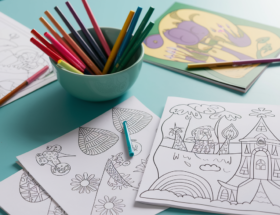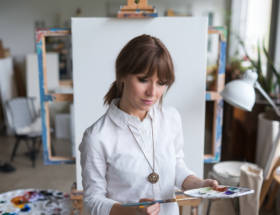Do you feel tired from daily life? Maybe you haven’t thought about using art for mental health. Painting can be more than just making art. It’s a way to relax and focus on your mind.
Art therapy has been around for a long time. Places like the Mayo Clinic use it to help patients. It makes you feel good and helps you stay hopeful.
Painting is not just for making pretty pictures. It’s a way to heal and feel better. Studies show it can make you feel happy and focused.
Art can really help your mental health. Whether you’re new to painting or have done it before, it can make you feel better.
Key Takeaways:
- Painting is not only an outlet for creative expression but also an effective form of mental health therapy.
- Programs like Mayo Clinic’s “Arts at the Bedside” and “Music is Good Medicine” series illustrate how art therapy benefits patient care.
- Research indicates a strong correlation between engaging in painting and increased serotonin and dopamine levels.
- Creative arts therapy can aid in treating a wide array of conditions, thereofore enhacing emotional and psychological resilience.
- Regularly engaging in painting has been shown to lower cortisol levels, foster mindfulness, and increase overall life satisfaction.
- Starting a painting practice can be pivotal in reducing anxiety and depression symptoms and improving focus.
- Even brief sessions of art therapy can lead to noticeable improvements in stress levels and brain function.
The Ancient Roots of Art Therapy
Art therapy goes back tens of thousands of years. It shows how art and healing were linked in ancient cultures. These early societies used art to help people feel better and to bring communities together.
Today, we see how ancient art therapy is used in modern therapy. It shows that art is always good for our minds and feelings.
Imagine the walls of old caves with paintings. These paintings were more than just pretty pictures. They helped people talk and heal.
The Use of Art in Healing Across Cultures
Art has always been important for healing and spirituality. From tribal dances to East Asian ink paintings, art helped people find peace. It shows that art is a universal way to heal and find well-being.
Evolution of Art Therapy into Modern Practice
In the 20th century, art therapy became a real therapy. It started in the 1940s in the US and Europe. Adrian Hill, a British artist, first called it “art therapy.”
By the mid-20th century, groups like The American Art Therapy Association were formed. They showed that art therapy was a serious and organized field.
| Year | Event |
|---|---|
| 1940s | Term “art therapy” coined by Adrian Hill. |
| 1964 | Establishment of The British Association of Art Therapists. |
| 1969 | Foundation of The American Art Therapy Association. |
This history helps us understand and use art therapy today. Art is a powerful way to heal and comfort people everywhere.
Mental Health and Painting: A Therapeutic Duo

Painting is more than just making art. It’s a big help for our minds. Mental health benefits of painting have been known for a long time. Elinor Ullman started using art therapy in 1953 in Washington, D.C. It has helped many people, including those with substance abuse issues.
Art lets people show their feelings without words. This helps them heal. Many people who were unsure at first now love art therapy. They ask for more materials to keep creating.
Art therapy helps people grow emotionally and feel better about themselves. It’s a real job that needs special training. It works in many places, helping people of all ages, even veterans and those with chronic illnesses.
Art therapists work with doctors to help people fully. This makes sure everyone gets the help they need.
Art therapy really changes lives. About 80% of people feel less anxious and stressed. Also, most art therapists know a lot about art and psychology. This helps them help others better.
| Benefits | Settings | Outcomes |
|---|---|---|
| Enhances self-esteem | Detox centers | Reduction in anxiety and stress by 80% |
| Improves self-awareness | Outpatient clinics | Effective in treating depression, anxiety, trauma |
| Manages behavior and addictions | Residential facilities | Increases demand for creative tools |
| Fosters emotional healing | Hospitals | Supports chronic condition management |
In short, painting and mental health together are very powerful. Emotional healing through art helps people in big ways. It lets them deal with their minds in new and good ways.
How Painting Enhances Emotional Well-being

The ancient brush strokes paint our emotions on canvas. They create beauty and have great healing power. Painting for stress relief is like opening a vent to release pressure. It’s amazing how it brightens both the room and the painter’s mind.
Brushing and blending colors brings calm. Studies show it lowers cortisol levels. Just a few minutes of art daily can boost mental health, like exercise.
Art lets us explore our feelings and life situations. Each color and stroke tells a story. It’s a way to understand and process complex emotions. This journey gives a voice to those who struggle to speak, improving mental health.
Art isn’t just for personal gain. It also builds social connections. Community art projects and workshops bring people together. They create joy and a sense of belonging.
Creating a space for art at home can be a sanctuary. It’s like gardening for your mind. Painting grows mindfulness, resilience, and a positive spirit. It’s a powerful way to communicate without words, boosting self-awareness and emotional intelligence.
The Science Behind Painting and Mental Wellness

Painting is more than just a hobby. It’s great for mental health and painting. Studies show that art therapy helps our minds a lot.
A study in 2016 found that painting for 45 minutes lowers stress. This shows how painting can make us feel better. Another study in 2017 found that painting increases blood flow to the brain. This shows how painting and mental health are connected.
A 2012 study found that coloring mandalas lowers anxiety more than free drawing. This shows that art can be a good therapy. Both new and experienced artists get the same health benefits from painting.
| Study | Focus | Outcome |
|---|---|---|
| 2018 Frontiers in Psychology | Flow state during art-making | Increases in theta and alpha wave activities |
| Long-term caregivers study | Impact of creative arts | Reduction in stress and anxiety, increase in positive emotions |
| Cancer patient therapy | Effect of guided art sessions | Improved psychological well-being |
In hospitals, art therapy helps patients feel better. It can even make them need less sleep medicine and leave the hospital sooner. This shows that painting is good for more than just art.
Art therapy is good for people with chronic illnesses and mental health issues. It helps them feel less stressed and function better every day. It gives them a way to express themselves and cope.
Many studies have shown that painting and art are good for our minds. They help our brains in many ways. This makes painting very important for our mental health.
Art Therapy: A Form of Non-verbal Communication

Art therapy is a special way to talk without words. It helps people show and understand deep feelings and experiences. This is great for kids with autism or anyone feeling very upset.
Art therapy lets thoughts and feelings come out through colors and shapes. Therapy through art goes beyond talking, reaching deep into our hearts and minds.
- Art therapy breaks down language barriers, letting everyone express themselves.
- It helps with mental health, making people feel better without drugs.
- It also makes relationships stronger by sharing feelings through art.
Many studies show art therapy works well. It helps with depression and anxiety. It also helps people with schizophrenia feel better.
Importance of Creative Expression in Therapy
Creative expression is more than just making art. It’s a way to heal and learn about ourselves. The American Art Therapy Association says it’s not just about the art made.
Art therapy makes life better, even for those with Alzheimer’s. It helps with thinking and feeling better, in ways regular therapy can’t.
Doing art makes people feel better about themselves. It lifts their spirits and helps their mental health. Art is a way to heal from deep wounds.
Art therapy shows the power of talking through art. It’s a key tool in mental health. As we learn more, we see how art can heal us, beyond words.
Painting for Relaxation and Mindfulness

Painting is more than making art. It’s a way to improve your mental health. Painting for relaxation and art techniques for wellbeing offer a calm escape from daily life.
Imagine mixing colors and painting on a canvas. It’s not just a dream. It’s backed by science. A huge 94% of people feel relaxed after 45 minutes of painting.
About 68% say painting helps them focus on the now. It makes them feel less stressed.
- Promotes deep focus and calms the mind.
- Helps overshadow current stresses through creation.
- Enables expression of difficult-to-verbalize emotions.
This practice makes you more mindful and improves your mental health. 70% of people feel better after painting regularly. Holding a paintbrush can even lower stress by 32% in half an hour.
Painting makes 80% of people happier and more content. It becomes a key part of their mental health plan. It’s more than just a hobby.
Techniques for Achieving Mindfulness Through Painting
Using art techniques like smooth watercolor blends helps you focus. These activities help you find peace and calm.
Examples of Relaxation-Inducing Art Activities
Coloring mandalas, sculpting clay, or sketching can be very therapeutic. These activities are fun and help you relax and focus.
Painting is seen as a form of meditation. It helps people find peace within themselves. So, grab your brushes and let painting guide you to calmness and mindfulness.
Promoting Self-discovery and Internal Healing

Mental health and painting are closely linked. Painting is more than art; it’s a way to discover yourself and heal inside. It lets you show your thoughts and feelings in a special way.
Studies show painting helps lower stress and anxiety. It also makes people feel better and can even help with depression. Art therapy can even lower stress hormones right away.
Painting helps you grow as a person. It makes you think about your feelings and what makes you upset. As you paint, you can see your feelings come to life.
Art therapy works for all ages and helps with many problems. It’s used in schools and hospitals to help people. Painting is a powerful tool for mental health.
Painting can help you learn more about yourself. It can help you heal from the past or just relax. It’s a powerful way to find yourself and heal inside.
Incorporating Painting into Your Mental Health Routine

Painting can make you feel good and help your mind. You can paint alone or with friends. Both ways are good for your mind.
Easy Ways to Start a Painting Practice at Home
Starting to paint at home is easy. You just need basic paints and some time. Try to paint every week. It’s good for your mind and helps you feel happy.
Utilizing Painting as a Solo and Group Therapy Tool
Painting can be very helpful, alone or with others. When you paint by yourself, you can share your feelings on canvas. It’s a way to say things you can’t say out loud.
Painting with friends can make you feel less alone. It helps you make friends and feel supported. Studies show that art projects help everyone feel better together.
Remember, painting is good for your mind. It helps you feel less stressed and more happy. Try painting alone or with friends to help your mental health.
| Benefits of Painting | Solo Therapy | Group Therapy |
|---|---|---|
| Reduces cortisol levels | Encourages self-expression | Creates social bonds |
| Releases dopamine and endorphins | Helps in exploring identity | Offers emotional support |
| Boosts self-esteem | Improves problem-solving skills | Reduces loneliness |
Conclusion
Painting is more than just making art. It helps us feel better inside. Every brush stroke is a step towards better mental health. Studies show that painting lowers stress and makes us happier.
Painting helps with anxiety, depression, and PTSD. It’s not just for fun. It makes our brains stronger and happier. It’s a way to feel good and stay strong.
The arts bring people together. They fight loneliness and help us feel connected. By painting, we heal ourselves and find happiness. So, grab your brush and start your journey to happiness.
FAQ
How can engaging in painting promote mental health?
Painting helps by reducing stress and boosting creativity. It lets people express feelings without words. This makes them feel better and more relaxed.
What is the historical significance of art in healing?
Art has always helped people heal. In many cultures, painting was used for therapy. Today, it’s a key part of modern therapy.
How does painting aid in stress reduction?
Painting helps by making you focus and relax. It’s like a break from the world. This can make you feel calm and stress-free.
Can painting help with mental health disorders?
Yes, painting is great for mental health. It’s used in therapy for anxiety, depression, and more. It helps with focus and feelings.
What are the neurological benefits of painting?
Painting makes your brain happy by releasing feel-good chemicals. It also helps your brain solve problems and feel hopeful.
How is art therapy used as non-verbal communication?
Art therapy lets people share feelings without words. It’s good for kids and those with disabilities. It helps them express and explore their emotions.
What techniques in painting foster mindfulness and relaxation?
Techniques like focusing on details and using watercolors help. They make you present and calm. This leads to a peaceful state.
How does painting encourage self-discovery and internal healing?
Painting lets you explore your feelings and thoughts. It shows your inner world. This can lead to deep insights and healing.
What are some ways to incorporate painting into my mental health routine?
Start with simple painting at home. Or join a class for fun and connection. Try exercises that help you relax and focus.
Can painting be effective in group therapy settings?
Yes, painting works well in groups. It creates a shared healing experience. It builds connections and supports everyone’s healing journey.









